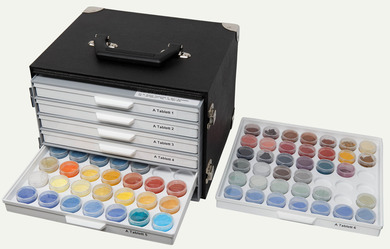Colours for word and image
Colours for word and image
Colours are acts of light.
Johann Wolfgang von Goethe, Theory of Colours, 1810
Substrates for writing can be painted, written or printed on, or stamped using chalks and charcoal, inks, Indian inks, paints or varnishes. This is done freehand using tools or using forms made for the purpose such as stamps or stencils. The means used to apply colour – soluble colourants or insoluble pigments – differ in shade and resistance to light. Only a limited range of enduring colourants were used over long periods in history to record text and images on substrates. A Chinese proverb says: “The palest ink lasts longer than the most retentive memory”.
Smalt, minium, auripigment, vermillion, azurite, malachite, lapis lazuli, chrysocolla, blue iron ore, indigo, rose madder, dragon’s blood, saffron and curcuma are the names of some of the historical colourants which artists and artisans of the Middle Ages, the Renaissance or the Baroque used in their work.

